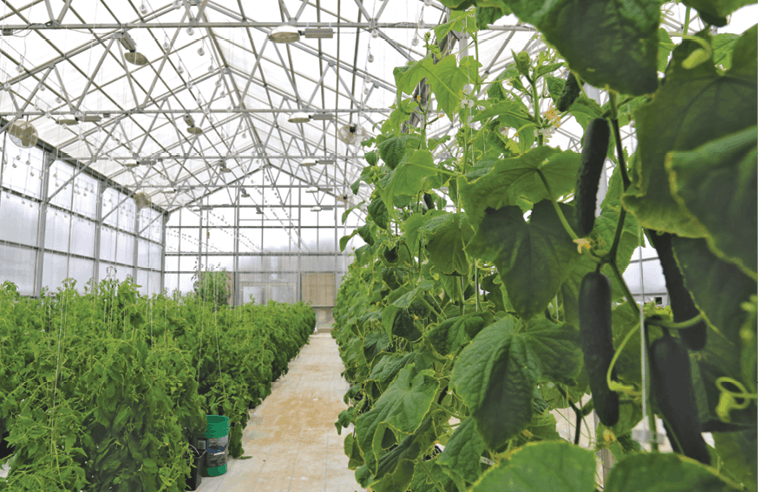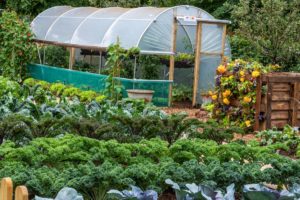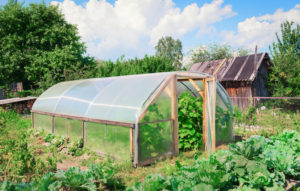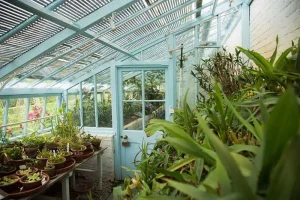Passive solar greenhouses offer a sustainable and energy-efficient way to grow plants year-round.
By leveraging natural sunlight and heat, these structures can provide the perfect conditions for plant growth without relying on expensive heating or cooling systems.
With careful design and planning, it’s possible to create a passive solar greenhouse that minimizes energy input while maximizing output.
We will explore the key elements of creating a passive solar greenhouse for minimal energy input.
Site selection
Choose a location that receives direct sunlight for most of the day. South-facing locations are ideal.
A south-facing location is ideal as it receives the most direct sunlight throughout the day, particularly during the peak summer months.
This direct sunlight exposure will help to promote healthy plant growth, increase photosynthesis, and boost the overall productivity of your aquaponic system.
A south-facing location will reduce the risk of frost damage during the winter months, allowing you to extend your growing season and enjoy a longer harvest.
By choosing a site that receives direct sunlight for most of the day, you’ll be well on your way to creating a thriving and productive aquaponic garden.
Design and orientation
Design the greenhouse to be long and narrow, with a south-facing wall that is largely glass. This will allow maximum solar gain and thermal mass absorption.
When designing a passive solar greenhouse, it is important to consider the orientation and layout of the structure.
To maximize solar gain and thermal mass absorption, the greenhouse should be designed as long and narrow, with a south-facing wall that is largely glass.
This orientation allows the sun’s rays to penetrate the greenhouse during the day, warming the interior space and providing optimal conditions for plant growth.
The glass wall also allows for maximum exposure to natural light, further enhancing the greenhouse effect.
The long and narrow shape helps to concentrate the sun’s rays and create a more stable and consistent temperature within the greenhouse.
By incorporating these design elements, you can create an ideal environment for your plants to thrive while minimizing the need for artificial heating and cooling.
Thermal mass
Use thermal mass materials such as concrete or brick to absorb and store heat during the day. These materials will release heat at night, providing a stable temperature.
Thermal mass is a material or structure that absorbs and stores heat energy during the day, then releases it at night to maintain a stable temperature.
Concrete and brick are common thermal mass materials, as they have high heat capacity and can absorb and store a significant amount of heat energy.
To utilize thermal mass effectively, it’s essential to design your building with a large south-facing window to allow natural light and heat to enter.
During the day, the thermal mass will absorb this heat energy and store it for later use.
As the sun sets and the room cools, the thermal mass will release the stored heat, maintaining a comfortable and stable temperature.
In addition, proper insulation and air sealing are important to ensure that the thermal mass can store and release heat effectively.
Proper installation and maintenance of the thermal mass system will also guarantee optimal performance.
With the right design and implementation, thermal mass can be a highly efficient and cost-effective solution for heating and cooling buildings.
Insulation
Use high-performance insulation to minimize heat loss during cold nights.
High-performance insulation is a critical component of any energy-efficient home.
During cold nights, it plays a vital role in minimizing heat loss and keeping your home cozy and warm.
There are various types of insulation available, each with its own set of benefits and features.
Some popular options include fiberglass, cellulose, and spray foam insulation.
When selecting insulation, it’s essential to consider factors such as R-value, moisture resistance, and air tightness.
It’s important to properly install the insulation to ensure maximum effectiveness.
This may involve hiring a professional or following specific guidelines for DIY installation.
Proper insulation can help reduce your heating costs, minimize your carbon footprint, and create a more comfortable living space.
With the right selection and installation, you can enjoy a warm and cozy home during even the coldest nights.
Ventilation
Use natural ventilation techniques such as vents, windows, and doors to allow air circulation and temperature regulation.
Using natural ventilation techniques can help to improve indoor air quality and regulate temperature levels without relying on mechanical systems.
This approach involves opening vents, windows, and doors to allow fresh air to circulate and stale air to escape.
By doing so, you can help to prevent the buildup of moisture and pollutants inside your home, which can reduce the risk of mold growth and improve overall indoor air quality.
Natural ventilation can help to regulate temperature levels by allowing warm air to escape and cool air to enter, which can help to reduce the need for air conditioning or heating.
To maximize the benefits of natural ventilation, it’s important to strategically locate vents, windows, and doors to ensure proper airflow and to minimize the need for mechanical systems.
By incorporating natural ventilation techniques into your home design and maintenance plan, you can enjoy a healthier, more comfortable living space while also reducing your environmental impact.
Shading
Incorporate shading devices such as louvers, awnings, or overhangs to reduce solar gain during hot summer months.
Incorporating shading devices such as louvers, awnings, or overhangs is an effective way to reduce solar gain during hot summer months.
These devices can be placed over windows, doors, and other openings to block direct sunlight and prevent it from heating up the interior of the building.
By obstructing the sun’s rays, shading devices can lower the temperature inside the building, reducing the need for air conditioning and saving energy.
Shading devices can also reduce glare and harsh lighting, creating a more comfortable and visually pleasing environment.
To maximize the effectiveness of shading devices, it is important to consider the building’s orientation, the position of the sun, and the materials used in the construction of the device.
For example, a building located in a hot and sunny climate may benefit from a louvered system that is designed to block direct sunlight during the hottest parts of the day.
On the other hand, a building in a cooler climate may not require as much shading, and a simpler awning or overhang may be sufficient.
By carefully considering the specific needs of the building and the local climate, homeowners and builders can choose the most effective shading devices to achieve optimal energy efficiency and comfort.
Water feature
Incorporate a water feature such as a pond or fountain to increase evapotranspiration and cool the greenhouse.
Incorporating a water feature into your greenhouse design can have a significant impact on the microclimate and overall health of your plants.
By incorporating a pond or fountain, you can increase evapotranspiration, which is the process by which plants release water vapor into the air.
This helps to cool the greenhouse and maintain a more consistent temperature and humidity level.
The soothing sound of running water can create a more relaxing environment for both you and your plants, and can even help to reduce stress and improve air quality.
When designing your greenhouse, consider incorporating a water feature, such as a small pond or fountain, to not only add visual interest but also to improve the overall microclimate and health of your plants.
Plant selection
Choose plants that are well-suited to the greenhouse climate and can thrive with minimal energy input. Consider using plants that have low water requirements and can tolerate a range of temperatures.
When it comes to selecting plants for your greenhouse, it’s essential to choose varieties that are well-suited to the unique climate and can thrive with minimal energy input.
Look for plants that have low water requirements, as this will not only save water but also reduce the need for heating and cooling.
Consider using plants that can tolerate a range of temperatures, as this will give you more flexibility in terms of the greenhouse’s climate control.
Some examples of low-maintenance plants that can tolerate a range of temperatures and humidity levels include succulents such as aloe vera and cacti, as well as tropical plants like begonias and bromeliads.
These plants are often easy to care for and can thrive in the greenhouse with minimal intervention.
Furthermore, consider using hydroponic systems to grow plants, which can be more energy-efficient and water-conserving compared to traditional soil-based growing methods.
Hydroponic systems can recirculate water and nutrients, minimizing waste and reducing the need for water and energy.
By choosing the right plants for your greenhouse, you can create a thriving and sustainable indoor garden that is easy to maintain and provides numerous benefits for your health and well-being.
Want More? Dive Deeper Here!
Hey there! If you’re the type who loves going down the rabbit hole of information (like we do), you’re in the right spot. We’ve pulled together some cool reads and resources that dive a bit deeper into the stuff we chat about on our site. Whether you’re just killing time or super into the topic, these picks might just be what you’re looking for. Happy reading!






